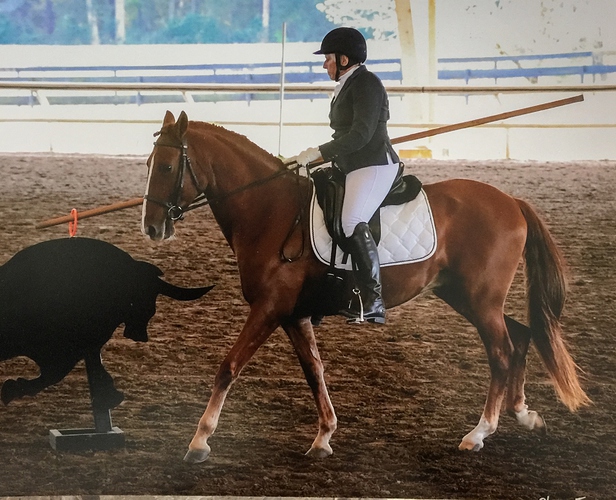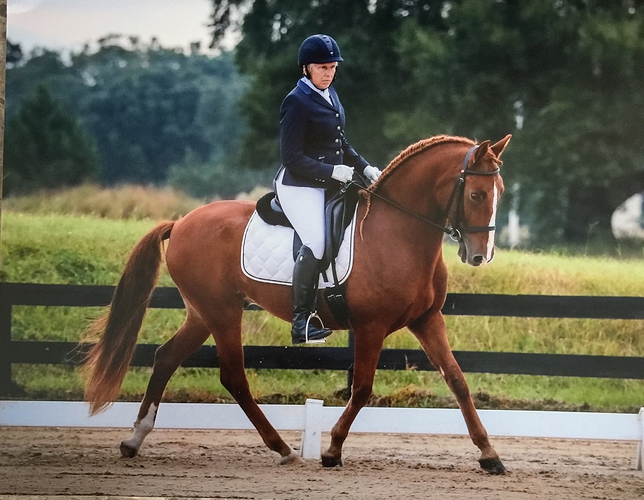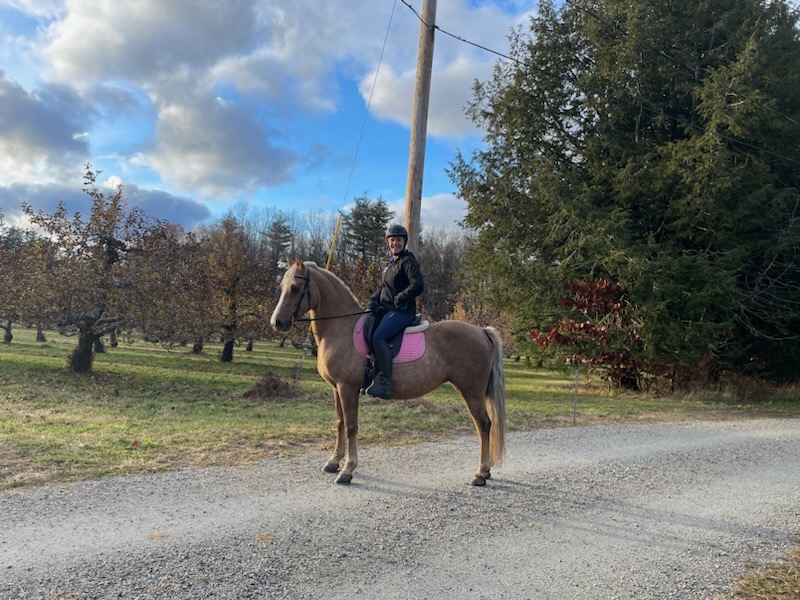I was asked to ride only on the weymouth in a few lessons as we moved from 4 to PSG… it ahd the same effect. Bravo got straighter and more over his back.
I am familiar with BEGI. Run by Bruno Gonzales and Tina Cristiana Veder. They are running their “own thing” focused on the old mange riding.
I have found that with my mare. I have tried 20 or so snaffles over her riding life. I finally gave up and switched to the curb bits exclusively and could not believe the positive difference in her tension, softness and just her ease at doing things. Luckily we are both at the place where we can do what we want. Would be problematic if we wanted to show.
I alternate between a Fager Maria eggbutt, a double bridle and a shanked dog bone snaffle with my guy. His connection in the snaffle has vastly improved over the past year, previously we lived in the dogbone. Some people get all flustered about the idea of a young horse in a shanked bit, but if you are riding correctly from back to front - active hind legs, engaged back, with straightness - the bit helps and doesn’t hurt.
I think it depends on the training, too. For example, Lider Seven, a stallion owned and trained by Jorge Gabriel at Casa Lusitana, was the All Breeds PSG champion last year. So clearly tey are capable of maintaining the contact required in competition, if trained to do so.
https://www.facebook.com/100082073228154/videos/1012270209531943/
There are definitely similar issues with Morgans, especially the more upright show-bred ones. This is one of the reasons I chose the trainer I did for Lola, my new Morgan pony. Juliane worked her way up at Casa Lusitana, and now has her own sales and training business, mostly Lusitanos. So she knows these horses tend to curl up behind the bit, be leg movers, learn the tricks easily before they learn to use themselves correctly, etc.
It also seems, unfortunately, that these horses often prefer non-legal bits. My older Morgan went fabulously in a short shanked Pelham with double jointed mouthpiece, until my stupid hand condition kept me from using double reins. On the bitless side, she preferred a little S hackamore over a sidepull. I’m a smurf, but I think the curb gives them somewhere to go when they uncurl.
This is what I like, and I’m never going to be a grand dressage rider, but I can see how the more baroque breeds would be frustrating to someone used to WBs.
My mare is warmblood, but was really tough to get into the contact. Very light in the face and would curl, and often stop rather than stepping into any kind of contact, always trying to “spit the bit out” as my main instructor would say. A clinician recommended a rubber bit, so I put her in a Bombers that is flexible in the middle, and she has improved immensely and we get nice bits of her being FDO, often some nice white lipstick. I don’t think the one I have is legal, but they do make one that looks like a regular Mullen which should be (I didn’t realize that it also flexes in the middle, or I would have gone with that).
Lola is going in a single joint full cheek right now, but will be switching to a full cheek mullen with a soft plastic mouth (Shires brand) if it ever shows up.
Meanwhile, I’m sure you can see the resemblance to an Iberian here, but she’s only 14 hands. Juliane’s young Lusitano stallion would love to have a date with her - but he’s huge! (Don’t worry; no foals wanted here!)
I had a Lusitano for a while (who was a bit fried, in his defense) that could only relax in the double bridle. He had a good understanding of contact and could school all the fourth level movements, but for some reason he just couldn’t just take a deep breath in the snaffle alone. The curb took away some kind of question that made him nervous and his whole outlook changed significantly.
Polite to the hand means the horse is softly responsive to the hand aid. No rooting, pulling on my hand, inverting, or head flipping. I should be able to shorten the rein and the horse shortens the neck appropriately without resistance or me having to give extra hand aids to bring him back. The horse understands the length of rein.
Having an educated mouth that knows to listen.
This has been an interesting read.
I bought my teenage daughter an Iberian cross a few years back (we werent looking for one, just looking for a safe horse for a junior rider) and I believe they were pretty good at faking things through first level and even into 2-1. Then we switched to a trainer that also rode an Iberian and in less than a year my daughter got her bronze.
My daughter always gets comments about tension on her tests and in the past year had to relearn quite a few things. Her horse takes more work than others for proper contact and using himself properly but it has come along well.
She just started using a double bridle and he took to it well. It’s really helping with some of the movements and reducing the tension.
Personally, I’d pick an iberian over a WB any day. The ones I have known are so willing and good eggs all around. I couldnt have picked a better match for my daughter (and he was affordable!). She does everything with him.
Interesting comments about double bridles working so well. Spanish and Portuguese equitation is based on using curb bits, IME one rarely finds a snaffle.
Curb bits offer lateral stability for the neck and shoulders. Many of these WE riders are riding one handed, where the action of the bit needs to be unified, not bifurcated by a joint in the middle. They don’t use the bit to steer (duh) and their seats are so solid and clear in defining bend, collection and extension - they only need the bit for pol flexion, elevation, and stability.
My coach injured her shoulder so she’s been riding one handed in curb bits - she still gets a lot done with each horse. It’s been interesting to watch.
Re:Working Eq: Here in the US, I believe one handed riding is restricted to and required at the upper levels.
USAWE Rulebook Section 1.11 Use of Hands
https://usawe.org/competitions/rules/
Horses may be ridden with one hand or two in all levels up through Intermediate B (L5). All trials in Advanced (L6) and Masters (L7) levels must be performed with the reins in one hand. Exception: Riders using a spade bit must use the reins in one hand regardless of level.
Competitors are free to use either hand to hold the reins, but may not, under penalty of disqualification, switch hands.
L1 through L5 competitors riding one handed are allowed to use two hands to adjust the reins or correct the horse, or switch to riding with two hands without penalty. L6 and L7 competitors and anyone riding with a spade bit will be disqualified if they have two hands on the reins for longer than necessary to adjust the reins. Any adjustment to the reins must be a momentary action, with the free hand touching behind the rein hand.




